V

Two or more
V is for Vori Vori – a thick soup with little balls made of corn flour, and cheese. It's a traditional dish also known as the soul food of Paraguay - one of 44 landlocked countries worldwide.
The name "vorí vorí" comes from the Guarani language. In Guarani, one way of specifying abundance is by repetition of a word. So, "vorí" is one, but "vorí vorí" can be two or more. Wikipedia
V is also for victory and vendetta and value, vice, virtue, verity, voracious, valuable virus, vademecum and va va voom...
V=5
V is also the number 5 in Roman numerals. Surely a curious system for counting. Each letter with a fixed integer value:
| I | V | X | L | C | D | M |
|---|---|---|---|---|---|---|
| 1 | 5 | 10 | 50 | 100 | 500 | 1000 |
and then you add or take away relative to these fixed divisions.
Reusing letters for numerical symbols – perhaps it's the Italian mind and a way of seeing things as parts of other things – the method carries over into time telling, 5:45 is still conveyed as 6 minus 15. Regardless, it gets messy real fast and we can thank the Hindus and the Arabs for saving the west from itself and such numerical shenanigans.

Base 10 / Base 12
My Dad (I had intended to post this on Father's Day:-) was a prodigious counter-upper. He would do all manner of calculations in his head - with the aid of the divisions of the fingers... he worked everything in Base 12! His thumb would go flying around amongst finger divisions, odd utterances and mutterings would escape his lips in an unknown (to me) poetic tongue - and he would magically have an answer in mere seconds. I was always amazed as a kid while plodding along with the Base 10 taught in School.

The Madness continues
Bushels, Pecks, Scores, Drams, Scruples – this video, suggested by D, sums things up tidily...

As always, thanks for reading and indulging!
Share via Email
PS: In perusing content for the letter V, I discovered that the Vaquita – the smallest of the dolphin family – is a critically endangered species and by some counts with as few as 10 remaining.
How is this even possible?


Member discussion